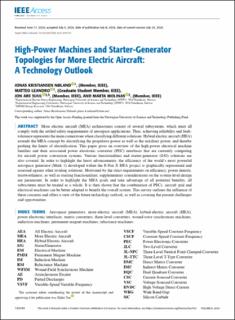| dc.contributor.author | Nøland, Jonas Kristiansen | |
| dc.contributor.author | Leandro, Matteo | |
| dc.contributor.author | Suul, Jon Are Wold | |
| dc.contributor.author | Molinas Cabrera, Maria Marta | |
| dc.date.accessioned | 2020-08-27T10:41:44Z | |
| dc.date.available | 2020-08-27T10:41:44Z | |
| dc.date.created | 2020-07-09T00:27:38Z | |
| dc.date.issued | 2020 | |
| dc.identifier.citation | IEEE Access. 2020, PP (99), . | en_US |
| dc.identifier.issn | 2169-3536 | |
| dc.identifier.uri | https://hdl.handle.net/11250/2675360 | |
| dc.description.abstract | More electric aircraft (MEA) architectures consist of several subsystems, which must all comply with the settled safety requirements of aerospace applications. Thus, achieving reliability and fault-tolerance represents the main cornerstone when classifying different solutions. Hybrid electric aircraft (HEA) extends the MEA concept by electrifying the propulsive power as well as the auxiliary power, and thereby pushing the limits of electrification. This paper gives an overview of the high-power electrical machine families and their associated power electronic converter (PEC) interfaces that are currently competing for aircraft power conversion systems. Various functionalities and starter-generator (S/G) solutions are also covered. In order to highlight the latest advancements, the efficiency of the world’s most powerful aerospace generator (Mark 1) developed within the E-Fan X HEA project is graphically represented and assessed against other rivaling solutions. Motivated by the strict requirements on efficiency, power density, trustworthiness, as well as starting functionalities, supplementary considerations on the system-level design are paramount. In order to highlight the MEA goals and take advantage of all potential benefits, all subsystems must be treated as a whole. It is then shown that the combination of PECs, aircraft grid and electrical machines can be better adapted to benefit the overall system. This survey outlines the influence of these concerns and offers a view of the future technology outlook, as well as covering the present challenges and opportunities. | en_US |
| dc.language.iso | eng | en_US |
| dc.publisher | Institute of Electrical and Electronics Engineers (IEEE) | en_US |
| dc.relation.uri | https://ieeexplore.ieee.org/stamp/stamp.jsp?tp=&arnumber=9136684 | |
| dc.rights | Navngivelse 4.0 Internasjonal | * |
| dc.rights.uri | http://creativecommons.org/licenses/by/4.0/deed.no | * |
| dc.title | High-Power Machines and Starter-Generator Topologies for More Electric Aircraft: A Technology Outlook | en_US |
| dc.type | Peer reviewed | en_US |
| dc.type | Journal article | en_US |
| dc.description.version | publishedVersion | en_US |
| dc.source.pagenumber | 20 | en_US |
| dc.source.volume | PP | en_US |
| dc.source.journal | IEEE Access | en_US |
| dc.source.issue | 99 | en_US |
| dc.identifier.doi | doi.org/10.1109/ACCESS.2020.3007791 | |
| dc.identifier.cristin | 1819002 | |
| dc.description.localcode | This work is licensed under a Creative Commons Attribution 4.0 License. For more information, see https://creativecommons.org/licenses/by/4.0/ | en_US |
| cristin.ispublished | true | |
| cristin.fulltext | postprint | |
| cristin.fulltext | original | |
| cristin.qualitycode | 1 | |

